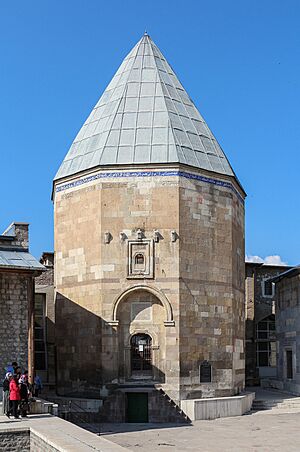Kilij Arslan II facts for kids
Quick facts for kids Kilij Arslan II |
|||||
|---|---|---|---|---|---|

Coinage of Kilij Arslan II, 1156-1192
|
|||||
| Seljuq Sultan of Rum | |||||
| Reign | 1156–1192 | ||||
| Predecessor | Mesud I | ||||
| Successor | Kaykhusraw I | ||||
| Died | August 1192 near Aksaray, Turkey |
||||
| Issue | Kaykhusraw I Suleiman II Qutbuddin Malik Shah Nuruddin Muqsed Muizz Muhyiddin Mesut Naser Nizam Arslanshah Sancarshah Gevher Nesibe Seljuki Fülane |
||||
|
|||||
| House | House of Seljuq | ||||
| Father | Masud I | ||||
| Religion | Islam | ||||
Kilij Arslan II was a powerful ruler, known as the Sultan of Rûm. He led the Seljuk Sultanate from 1156 until he passed away in 1192. His full name was ʿIzz ad-Dīn Kilij Arslān ibn Masʿūd. In Modern Turkish, his name Kılıç Arslan means "Sword Lion." He was a very important figure in the history of his time.
Contents
Kilij Arslan II's Reign as Sultan
Kilij Arslan II became the Sultan of Rûm in 1156. His reign was marked by many important events and conflicts. He often faced challenges from the Byzantine Empire and other powerful leaders.
Early Conflicts and Diplomacy
In 1159, Kilij Arslan attacked the Byzantine emperor Manuel I Comnenus. This happened as Manuel was returning from talks in Syria. Later, in 1161, Manuel's nephew defeated Kilij Arslan. After this, the Sultan traveled to Constantinople to show his respect and willingness for peace.
An interesting meeting happened in 1172. Kilij Arslan met Henry the Lion, a German duke, near Tarsus. The Sultan greeted Henry warmly, saying they were "blood cousins." He explained that a German noblewoman had married a Russian king. Their granddaughter then came to his land, and he was a descendant of her. This shows how connected royal families were back then!
Peace and Renewed War
By 1173, Kilij Arslan was at peace with the Byzantines. He even teamed up with another leader, Nur ad-Din, against the city of Mosul. However, this peace with the Byzantines did not last long.
In 1175, Kilij Arslan refused to give certain lands to Emperor Manuel. Both sides had been preparing for war. Kilij Arslan tried to negotiate, but Manuel invaded the Sultanate in 1176. Manuel wanted to capture Kilij Arslan's capital city, Iconium (modern-day Konya).
The Battle of Myriokephalon
Kilij Arslan's army met Emperor Manuel's forces at the Battle of Myriokephalon. The Sultan's army won a major victory. This forced the emperor to agree to a fragile peace treaty. This battle was a big moment for the Seljuk Sultanate.
Later Years and Challenges
In 1179, Kilij Arslan captured Henry I of Champagne, a famous count returning from Jerusalem. He held Henry for ransom. The Byzantine Emperor paid the ransom, and Henry was released.
After Emperor Manuel's death in 1180, the Byzantine Empire became unstable. Kilij Arslan took advantage of this. He gained control of much of the southern coast of Anatolia. He also formed an alliance with Saladin, a powerful Muslim leader. In 1182, he captured the city of Cotyaeum from the Byzantines.
Dividing the Sultanate
In 1185, Kilij Arslan made peace with the new Byzantine Emperor, Isaac II Angelus. However, the next year, he made a decision that caused problems. He divided his sultanate among his eleven sons. This led to his sons immediately fighting each other for control.
Even though Kilij Arslan was allied with Saladin, he promised the armies of the Third Crusade safe passage. These Crusaders were led by Frederick Barbarossa. However, Kilij Arslan's sons, who were local rulers, did not agree. They fought against the Crusaders in battles like the Battle of Philomelion and the Battle of Iconium.
After the Crusaders left, his eldest son, Qutb al-Din, took control of Konya. Kilij Arslan II had to escape and found refuge in Kayseri. Qutb al-Din even declared himself the new Sultan. But his father and his brother Kaykhusraw I drove him out of Konya in 1192. They chased him to Aksaray and surrounded the city.
Kilij Arslan II passed away during the siege of Aksaray in August 1192. He was 77 years old. Before he died, he promised the succession to his son Kaykhusraw I. He was buried in the Alâeddin Mosque in Konya. After his death, his other sons continued to fight for control of the sultanate.
Kilij Arslan II's Children
Kilij Arslan II had many children. In 1186, he divided his Sultanate among his 11 sons and 3 daughters. This decision, while meant to share power, unfortunately led to conflicts among them.
His children included:
- Qutb al-Din (who ruled in Sivas and Aksaray)
- Rukn al-Din (who ruled in Tokat)
- Nur al-Din (who ruled in Kayseri)
- Kaykhusraw I (who later became Sultan)
- Gevher Nesibe Khatun (a daughter)
- Seljuki Khatun (another daughter)
| Preceded by Mesud I |
Sultan of Rûm 1156–1192 |
Succeeded by Kaykhusraw I |


